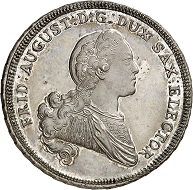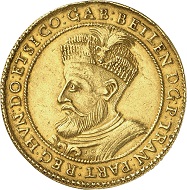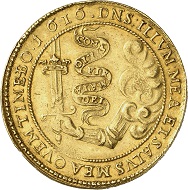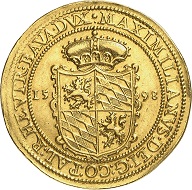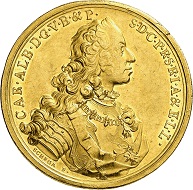04-10-2018 – 11-10-2018
Auction 311-315
200,000 Euros for Bavarian Gold Multiple at Künker
Auction house Künker held five auctions at once from October 5th to October 12th, 2018 all of which included an abundance of specialized collections. As expected, bidders rejoiced at this varied selection of offers. The 8,038 lots, which were initially estimated at 7.1 million euros, fetched at a total of 11.3 million euros.
This included numerous spectacular results that created quite a stir in the auction hall. What is more important, however, is that the coins and medals offered in the “middle” price segment brought in very satisfactory results as well. That goes to show how sound the coin market really is.
No. 1335: Orders and decorations. Kingdom of Saxony. Dynastic Order of the Rue Crown, breast star, of Biennais (1807/8). Example from Emperor Napoleon taken from the “Waterloo loot”. Estimate: 75,000 euros. Realized: 110,000 euros.
Auction 311: Orders and decorations
Let us first take a look at a side branch of numismatics: phaleristics. For several years now, Künker have been holding successful auctions of orders and decorations and so they did this fall. Three collections were auctioned off: the first part of the Peter Groch Collection, the Gunther Wiegrebe Collection of Lippe, as well as a large selection of orders and decorations made in Bulgaria between 1878 and 1991. The 1,440 lots of this auction were estimated at 546,000 euros and sold at a total hammer price of 825,000 euros.
No. 1688. Celts / England. Regini and Atrebates. Verica. 10-40. Gold stater, 25-35. Extremely fine. From Dr W. R. Collection. Estimate: 2,000 euros. Realized: 4,600 euros.
Auction 312: Coins from the ancient world
Auction catalog 312 started with the extensive Dr W. R. Collection of Celtic coins. They all stand out due to their exceptionally good condition which bidders certainly appreciated at this auction. Let us take a gold stater of Verica, ruler of the Regini and Atrebates between 10 and 40 A.D., as an example. The stater was of exceptionally good style, centered perfectly, and sharply struck. Consequently, the price went up from 2,000 to 4,600 euros.
No. 2015. Celts / Boii. Busu. Tetradrachm, 1st century B. C. Rare. Almost extremely fine / Very fine. Estimate: 2,500 euros. Realized: 7,500 euros.
Along with the Dr W. R. Collection, Künker also offered a variety of Celtic coins taken from other collections as well, including a batch of coins and medals from Noricum and Bohemia. These interesting pieces – which are also of exceptionally good grade – were very popular. The bidding for a tetradrachm with the inscription BVSV from the 1st century B.C. did not end until the estimate of 2,500 euros had tripled to 7,500 euros. Who or what said Busu was, and what kind of creature is depicted on the reverse, has yet to be researched.
No. 2341. Ionia. Undefined mint. Electrum 1/3 stater, 600-550. Very rare. Very fine. From Eberhard Link Collection. Estimate: 2,000 euros. Realized: 16,000 euros.
An early electrum coin from Ionia and Lydia taken from the Link Collection became the highlight of ancient coins. The collector had compiled the pieces over the course of many decades and had always paid close attention to quality. Bidders acknowledged that. For example, a very fine, well struck, fully centered 1/3 stater featuring a geometric pattern from an unknown Ionic mint rose from 2,000 to 16,000 euros.
No. 2295: Lampsacus (Mysia). Gold stater, 367-344. Very rare. Very fine+. From the Collection of History Enthusiast. Estimate: 12,500 euros. Realized: 38,000 euros.
The fact that collectors do appreciate rarity is proven by a mysterious obol from Phoenicia. Its dating and origin are heavily disputed. It was estimated at 200 euros, but the hammer price increased to a total of 4,000 euros.
No. 3502. Merovingians. Triens, Cologne, end of 6th century. Extremely rare. Very fine. From Bankhaus Sal. Oppenheim Collection. Estimate: 10,000 euros. Realized: 22,000 euros.
Auction 313: The minted history of Cologne
The third day of Künker’s fall auction began with the Bankhaus Salomon Oppenheim Collection of coins and medals from Cologne. The results matched the rarity and quality of the material.
A Merovingian triens, minted at the end of the 6th century, sold for 22,000 euros (estimate: 10,000 euros). An extremely rare bracteate of Reinald of Dassel, who bestowed the relics of the Three Kings on Cologne, was sold at 7,000 euros (estimate: 2,000 euros). A numismatically extremely important, undated goldgulden (possibly Riel 1364) changed hands at 20,000 euros. Bidders were also vying for a beautiful reichstaler.
No. 3624: Gebhard Truchsess of Waldburg, 1577-1583. Reichstaler 1583, Werl. “protestant trutztaler”. Extremely rare. Very fine. From Bankhaus Sal. Oppenheim Collection. Estimate: 7,500 euros. Realized: 20,000 euros.
A so-called “protestant trutztaler” serves as an example here. It was minted after the removal of the archbishop of Cologne Gebhard of Waldburg from office when he converted to Protestantism. The hammer fell at 20,000 euros (estimate: 7,500 euros).
No. 3724. Cologne. Off-metal strike in gold of 4 goldgulden from the dies of the dreikönigstaler n.d. (around 1620). Extremely rare. Very fine. From Bankhaus Sal. Oppenheim Collection. Estimate: 50,000 euros. Realized: 110,000 euros.
The highlight of this auction was – as expected – the bidding war for an off-metal strike in gold of the dreikönigstaler to the weight of 4 gulden. Its new owner was willing to raise their bid card at 110,000 euros.
No. 4285. Mecklenburg-Strelitz. Adolph Frederick III, 1708-1752. Reichstaler 1717 (minted in 1718), Lübeck marking the 200th anniversary celebration of the Reformation. Very rare. Extremely fine. Estimate: 3,500 euros. Realized: 15,000 euros.
Auction 314: Collection of Mecklenburgian coins – Saxonia in Nummis – Coins and medals from the Middle Ages and the Modern period
Collecting coins is a joy because one gets to hold a piece of history in their own hands. But it is also makes sense financially. This often becomes apparent when specialized collections, just like the collection of Mecklenburgian coins that initiated auction 314, are sold.
And as per usual, there were some surprises, as for example the pair of medals from 1708: Christian Wermuth created a medal celebrating the wedding of Sophie Luise of Mecklenburg-Schwerin and Frederick I of Prussia. When the Richard Gaettens Collection was auctioned off in 1931, Gaettens knew of only one other tin specimen along with his silver version. Künker could not only offer the medal in silver but also in bronze. The silver version was sold at 5,500 euros (estimate: 2,500 euros), the bronze version changed hands at 3,800 euros (estimate: 400 euros).
No. 4392: Saxony. Frederick III the Wise and John, 1486-1525. Thick guldengroschen 1522, Annaberg. Very rare. Very fine+. Saxonia in Nummis Collection. Estimate: 2,500 euros. Realized: 12,000 euros.
Up next was “Saxonia in Nummis” and the results gave proof to the popularity of this field of collection. The second lot already, a thick guldengroschen from 1522 had been estimated at 2,500 euros but realized 12,000 euros. And that was not the only surprise.
Let us have a look at the other important pieces. A fine to very fine thick triple reichstaler struck in Dresden in 1604 sold for 17,000 euros (estimate: 2,500 euros) and a fine to very fine thick quadruple reichstaler struck in Dresden in 1609 was auctioned off at 14,000 euros (estimate: 1,500 euros). That leads to the conclusion that collectors are very much willing to accept a somewhat poorer condition if they get the chance to acquire a multiple taler.
No. 4569: Saxony. Frederick August I, 1694-1733. Ordenstaler n. d. (1705), Dresden, celebrating the restoration of the Polish Order of the White Eagle. Very rare. Nearly FDC. Saxonia in Nummis Collection. Estimate: 20,000 euros. Realized: 38,000 euros.
Yet, they are of course even more willing to spend a lot of money when perfect condition and great rarity coincide, as they did with the ordenstaler of Augustus the Strong, the price of which rose from an estimate of 20,000 euros to the hammer falling at 38,000 euros.
No. 4571: Saxony. Frederick Augustus I, 1694-1733. Schmetterlingstaler worth 32 groschen. Very rare. Extremely fine to FDC. Saxonia in Nummis Collection. Estimate: 20,000 euros. Realized: 42,000 euros.
The popular coins and medals depicting butterflies did not fall short of anyone’s expectations, either. The price of the piece worth 32 groschen and 16 groschen respectively was realized at 42,000 euros (estimates: 20,000 euros and 15,000 euros), the piece worth 4 groschen, which was offered “only” in very fine+, sold for 7,000 euros (estimate 1,000 euros).
No. 4647. Saxony. Francis Xavier, 1763-1768. Double convention taler 1766, Dresden. As a reward of assiduity. Extremely rare. First strike. FDC. Saxonia in Nummis Collection. Estimate: 10,000 euros. Realized: 75,000 euros.
The highest result of “Saxonia in Nummis” was a double convention taler minted as a reward of assiduity in Dresden in 1766 depicting the portrait of Francis Xavier. It changed hands at 75,000 euros (estimate: 10,000 euros). Perhaps this high result can be linked to the fact that Francis Xavier was the founder of the Mining Academy of Freiberg which remains active to this day.
No. 8240. Saxony. Frederick Augustus I, 1694-1733. 3 ducats 1711, Dresden, celebrating the vicariate. Extremely rare. Extremely fine. Estimate: 10,000 euros. Realized: 42,000 euros.
We conclude the “Saxonia in Nummis” section with a look at coins and medals stemming from various collections which were offered in catalogs 314 (silver) and 315 (gold). Several impressive prices were realized here too, one representative example being a triple ducat of Augustus the Strong celebrating the vicariate of 1711. This piece had been estimated at 10,000 euros but sold for 42,000 euros.
No. 5512: Jülich-Berg. John III, 1511-1539. Guldengroschen n. d., probably Mühlheim mint. Extremely rare. Very fine to extremely fine. Estimate: 60,000 euros. Realized: 70,000 euros.
Although the market for German coins and medals is very strong, its results are not quite as impressive as the ones we encounter in other fields. It comes as no surprise that the most expensive coin here was a guldengroschen from Jülich-Berg, issued by Duke John III. It features the conversion of Saint Hubertus including a lot of details. A collector won the bid at 70,000 euros.
No. 5725. Regensburg. Henry II the Wrangler, 985-995 (Second reign). Denarius, Cham. Very rare. Very fine. Estimate: 750 euros. Realized: 1,800 euros.
The J. G. Collection of Moneta Radasponensis encompassed almost 200 lots of medieval coins of Regensburg. Specialized collectors got their chance here because being passionate about medieval pfennings requires a lot of knowledge. Which, on the other hand, is the reason why the coins of that time can be acquired at quite a low price considering their rarity. Even though the collector who wanted to become the new owner of the denarius of Henry the Wrangler from Cham still had to pay 1,800 euros for it (estimate: 750 euros).
No. 7358: Hungary / Transylvania. Gabriel Bethlen, 1613-1629. 10 ducats 1616. Very rare. Nearly extremely fine. Estimate: 25,000 euros. Realized: 75,000 euros.
Auction 315: World gold coins and medals, among others a collection of Bavarian gold rarities and the Eberhard Link collection of Mainz / German coins after 1871 / Russian coins and medals
The results of auction 315 prove that not only gold, but also gold coins are in vogue. Some fitting examples are the three enticing papal quadrupla pieces: All of them, minted on behalf of Clement VIII (1598, Avignon), Paul V (1608, Rome), and Innocent X (1647, Avignon), were estimated at 10,000 euros. The first quadrupla sold for 28,000 euros, the second one for 22,000 euros, and the third one for 26,000 euros.
Transylvania certainly kept up with these results. The hammer price for a very rare, almost extremely fine 10 ducat piece from 1616, struck on behalf of Gabriel Bethlen, amount to 75,000 euros.
No. 7702: Bavaria. Maximilian I, 1598-1615. 8 ducats 1598, Munich, celebrating his homage. Very rare. Extremely fine. Bavaria Collection. Estimate: 30,000 euros. Realized: 140,000 euros.
The highlight of this auction was the specialized collection containing 180 Bavarian gold coins and medals. The breathtakingly beautiful pieces saw equally breathtaking results.
The second lot already, an extremely fine 8 ducat piece minted in 1598 celebrating the homage of Maximilian I of Bavaria, had been estimated 30,000 euros and realized an impressive 140,000 euros.
No. 7750: Bavaria. Charles Albert, 1726-1745, Emperor Charles II since 1742. 20 ducats 1739, Munich. Extremely rare. Extremely fine. Bavaria Collection. Estimate: 50,000 euros. Realized: 200,000 euros.
And this result was exceeded by a 20 ducat piece from 1739 which Charles Albert had minted in the context of his diplomatic efforts of becoming emperor. It sold for an impressive 200,000 euros (estimate: 50,000 euros).
No. 8133. Mainz. Konrad III of Dhaun, 1419-1434. Weißpfennig (groschen) 1425, Bingen. Extremely rare. Extremely fine+. Eberhard Link Collection. Estimate: 500 euros. Realized: 4,000 euros.
The results of the Eberhard Link Collection of gold and silver coins of the archbishops of Mainz from the Bingen mint could not keep up with the aforementioned. But any specialized collector was probably still impressed by the oldest coin of the archdiocese of Mainz depicting the year of issue of 1425 selling for 4,000 euros despite its “fine” condition (estimate: 500 euros)!
Of course, the goldgulden were particularly popular. An extremely fine piece by Gerlach of Nassau sold for 5,000 euros (estimate: 1,000 euros) and the very fine+ gulden of his successor changed hands at 5,500 euros (estimate: 2,000 euros).
No. 8907: Russia. Tsar Peter III, 1762. 10 rubles, St Petersburg. Very rare. Extremely fine. Estimate: 20,000 euros. Realized: 38,000 euros.
Künker’s auction week closed with German coins after 1871 and coins and medals from Russia. The results in this section were also more than satisfactory.
You can find all of the results online on the Künker website.
The next auction will take place on January 31, 2019 in the context of the World Money Fair in Berlin. Consignments are still being accepted. Please feel free to contact the friendly Künker team: Nobbenburgerstr. 4a, 49076 Osnabrück; phone: 0541 / 96202 0; fax: 0541 / 96202 22; or via e-mail.





























